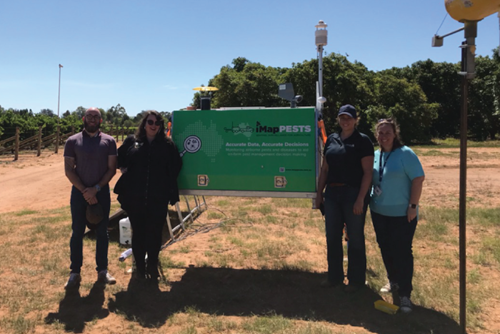
THE SuniTAFE SMART Farm has played a critical role in a program to improve bio-security preparation, resilience, and responsiveness to pests in horticulture and agriculture.
The ‘iMapPESTS: Sentinel Surveillance for Agriculture’ program was made possible through a $21 million partnership. Led by Hort Innovation, with funding from the Australian Government’s Rural Research and Development for Profit Program, as well as 16 partner organisations.
The program ran over five years, with the SuniTAFE SMART Farm becoming home to a ‘sentinel’ mobile unit from December 2021. For three months, this unit collected pests to assist understanding about localised pest populations that might be relevant to growers in the region.
“The research, development and extension activities of this program aimed to put actionable information into the hands of primary producers by changing the way we monitor airborne pest and diseases,” iMapPESTS Project Co-ordinator Shakira Johnson said.
“Part of the project is the development of these mobile surveillance units we call sentinels; the sentinels have been trialled across various growing regions within Australia.”
“In this final stage, we were developing case studies that would look at different industries and growing regions and one of the regions identified was Mildura with a focus on the citrus industry.”
“The case study was looking at early detection of biosecurity targets interest in that industry.”
Ms Johnson said the diversity of crops at the SuniTAFE SMART Farm deemed it the “ideal” location for the study to take place to gain insights into pest populations that might be relevant to many of the plant industries in the region.
“We wouldn’t have been able to do it without the help from the SuniTAFE SMART Farm team, it was an incredibly impactful collaboration,” she said.
“Collaborating with people who are enthusiastic and have an understanding of what we are trying to do is so important and our experience at the SMART Farm has been above and beyond.”
The sentinel mobile unit is part of a nationwide R&D collaborative initiative between Australia’s major plant industries. Its goal was to develop a way of rapidly monitoring and reporting the presence of airborne pests and diseases for multiple agricultural sectors, including viticulture, grains, cotton, sugar, horticulture and forestry.
The mobile nature of the sentinel unit enables the surveillance technology to provide localised information that impacts a specific region. This information might not apply to growing regions in other parts of the country.
The sentinel is equipped with several airborne samplers, power supply, a climate sensor, telemetry and an industrial computer to remotely control and monitor the unit. It even includes automated robotics to change pots on the pest samplers according to the day or capture criteria. The pest samples generated at the SuniTAFE SMART Farm were collected once a week and shipped to different diagnostics labs around Australia.
“Using the technology we trialled in Mildura, it helped us understand how we can monitor for industry and give them information that will enhance their pest management decision making,” Ms Johnson said.
“With the trial now finished in Mildura, researchers are inspecting the traps, they are analysing the data and using a new method that can tell all the different types of species that are present in the region.
“It’s important to understand what is hanging around the crops so that you can be a step ahead of pest pressure.
An important outcome of the project overall is an industry of growers that are better prepared for pest invasions.
Following the conclusion of the project, the data has been received and analysed and was recently shared with key industry stake-holders at an event held at the SuniTAFE Smart Farm.
For those interested in hearing about the results, keep your eyes out for an upcoming article on the SuniTAFE website.